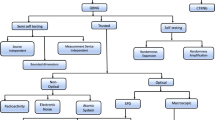Abstract
The definition of conditional probability in the case of continuous distributions (for almost all conditions) was an important step in the development of mathematical theory of probabilities. Can we define this notion in algorithmic probability theory for individual random conditions? Can we define randomness with respect to the conditional probability distributions? Can van Lambalgen’s theorem (relating randomness of a pair and its elements) be generalized to conditional probabilities? We discuss the developments in this direction. We present almost no new results trying to put known results into perspective and explain their proofs in a more intuitive way. We assume that the reader is familiar with basic notions of measure theory and algorithmic randomness (see, e.g., Shen et al. ??2013 or Shen ??2015 for a short introduction).
Similar content being viewed by others
Notes
In fact, the example in [1] has an additional property that our example does not have: the set of α 1 for which P(⋅|α 1) is not computable with oracle α 1, has positive P 1-measure. The distribution constructed in Example 3 (see below) also has this property, see also [2, Corollary 1]. On the other hand, the example in [1] has a conditional distribution P(⋅|α 1) that is continuous in α 1, unlike Example 3. A simplified construction of a continuous (in α 1) distribution can be found in [2, Theorem 5].
2 Since P is computable, we can compute v(U 1|S) for each U 1 and S with arbitrary precision. The only exception is the case when P(S) = 0; to avoid this problem, let us agree that we start processing stripe S only after we discover that P(S) > 0. In this way we lose all stripes with P(S) = 0 but this does not matter since these stripes do not contain random pairs (α 1, α 2). (Recall that our goal was to prove that (α 1, α 2) is not random contrary to the assumption.)
Note that a U 1-good stripe may have empty intersection with U 1, so this does not prevent us from adding some stripes that intersect U 2 but not U 1.
It would be interesting to derive the statement of the infinite theorem using the formula for expectation-bounded deficiency in terms of prefix complexity and the formula for the complexity of pairs, but it is not clear how (and if) this can be done.
References
Ackerman, N.L., Freer, C.E., Roy, D.M.: Noncomputable conditional distributions 26th Annual IEEE Symposium on Logic in Computer Science (LICS), pp 107–116 (2011). See also: On the computability of conditional probability, arXiv:1005.3014v2.pdf
Bauwens, B.: Conditional measure and the violation of van Lambalgen’s theorem for Martin-Löf randomness. arXiv:1509.02884 (2015)
Bienvenu, L., Gács, P., Hoyrup, M., Rojas, C., Shen, A.: Algorithmic tests and randomness with respect to a class of measures Proceedings of the Steklov Institute of Mathematics, vol. 274, pp 34–89 (2011). doi:10.1134/S0081543811060058. See also arXiv:1103.1529
Kjos-Hannsen, B.: The probability distribution as a computational resource for randomness testing. J Log Anal 2(1), 1–13 (2010). doi:10.4115/jla.2010.2.10. See also arXiv:1408:2850
de Leeuw, K., Moore, E.F., Shannon, C.E., Shapiro, N.: Computability by probabilistic machines. Automata studies, edited by C.E. Shannon and J. McCarthy, Annals of Mathematics studies no. 34, lithoprinted, pp 183–212. Princeton University Press, Princeton (1956)
van Lambalgen, M.: The axiomatization of randomness. J. Symb. Log. 55(3), 1143–1167 (1990). http://www.jstor.org/stable/2274480
Shen, A.: Around Kolmogorov complexity: basic notions and results Measures of Complexity: Festschrift for Alexey Chervonenkis. See also: arXiv:1504.04955, pp 75–116. Springer (2015)
Shen, A., Uspensky, V., Vereshchagin, N.: Kolmogorov complexity and algorithmic randomness, Moscow, MCCME. English version: http://www.lirmm.fr/ashen/kolmbook-eng.pdf (2013)
Takahashi, H.: On a definition of random sequences with respect to conditional probability. Inf. Comput. 206(12), 1375–1382 (2008)
Takahashi, H.: Algorithmic randomness and monotone complexity on product space. Inf. Comput. 209(2), 183–197 (2011)
Takahashi, H.: Generalization of van Lambalgen’s theorem and blind randomness for conditional probability, arXiv:1310.0709
Vovk, V.G., V’yugin, V.V.: On the empirical validity of the Bayesian method. J. R. Stat. Soc. Ser. B Methodol. 55(1), 253–266 (1993)
Acknowledgements
We are grateful to the organizers of the “Focus Semester on Algorithmic Randomness” (June 2015): Klaus Ambos-Spies, Anja Kamp, Nadine Losert, Wolfgang Merkle, and Martin Monath. We thank the Heidelberg university and Templeton foundation for financial support. The visit of Hayato Takahashi to LIRMM was supported by NAFIT ANR-08-EMER-008-01 grant.
Alexander Shen thanks Vitaly Arzumanyan, Alexey Chernov, Andrei Romashchenko, Nikolay Vereshchagin, and all members of Kolmogorov seminar group in Moscow and ESCAPE team in Montpellier.
Hayato Takahashi was supported by JSPS KAKENHI grant number 24540153.
Alexander Shen was supported by ANR-15-CE40-0016-01 RaCAF grant.
Last but not least, we are grateful to anonymous referees for very detailed reviews and many corrections and suggestions.
Author information
Authors and Affiliations
Corresponding author
Additional information
This article is part of the Topical Collection on Special Issue on Computability, Complexity and Randomness (CCR 2015)
The paper records the discussion of conditional randomness results by the participants of the Heidelberg Focus Semester on algorithmic randomness, 2015 (Laurent Bienvenu, Mathieu Hoyrup, Rupert Hölzl, Wolfgang Merkle, Jason Rute and others).
Rights and permissions
About this article
Cite this article
Bauwens, B., Shen, A. & Takahashi, H. Conditional Probabilities and van Lambalgen’s Theorem Revisited. Theory Comput Syst 61, 1315–1336 (2017). https://doi.org/10.1007/s00224-017-9789-2
Published:
Issue Date:
DOI: https://doi.org/10.1007/s00224-017-9789-2




